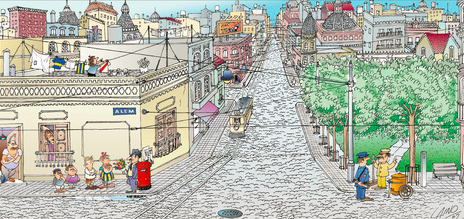 J. Osvaldo Laino (or simply “Laino”) was born in Rosario, Argentina in 1929. Having published his first works in the 1940s he worked as a cartoonist and illustrator for several Argentinian newspapers and magazines during the 1950s. In addition to that he became the director of then well-known art magazine Dibujantes and pioneered the first TV program with comic strip artists on Buenos Aires’ Channel 7. After a short stint in Venezuela he left for New York in ’61 and stayed there for 15 years. The mid-70s saw him and his wife moving to Florida where they opened an advertising agency. Finally, in 2006, the two moved back to Argentina. Laino still draws cartoons and has started to publish an online version of Dibujantes.
J. Osvaldo Laino (or simply “Laino”) was born in Rosario, Argentina in 1929. Having published his first works in the 1940s he worked as a cartoonist and illustrator for several Argentinian newspapers and magazines during the 1950s. In addition to that he became the director of then well-known art magazine Dibujantes and pioneered the first TV program with comic strip artists on Buenos Aires’ Channel 7. After a short stint in Venezuela he left for New York in ’61 and stayed there for 15 years. The mid-70s saw him and his wife moving to Florida where they opened an advertising agency. Finally, in 2006, the two moved back to Argentina. Laino still draws cartoons and has started to publish an online version of Dibujantes.
Given this long a career – my parents were hardly even born when Laino started to publish his work – I had to ask him to tell about the past.
![]() Mr. Laino, do you remember the first cartoon of yours that got published?
Mr. Laino, do you remember the first cartoon of yours that got published?
I remember it quite well. I was about 11 or 12 years old and a local weekly tabloid-type publication hired me for the task. In addition to the agreed-upon sum, I was given my first “journalist” I.D. card.
With this prized possession I decided to attend a major soccer game. To my utter surprise, I was “politely” thrown out of the stadium upon presentation of the aforementioned I.D. card. Needless to say, the publication never intended for that card to be really used by an 11-year-old. I returned home disillusioned and humiliated. However, this incident did not deter me from pursuing what was going to be my lifelong career.
What was the punchline of that first cartoon?
As far as I remember it was a strip of three or four panels, Disney-style, with a boy and a girl into some kind of an adventure trip. The name of the boy was Jolito – that’s my initials in diminutive – but I don’t recall hers.
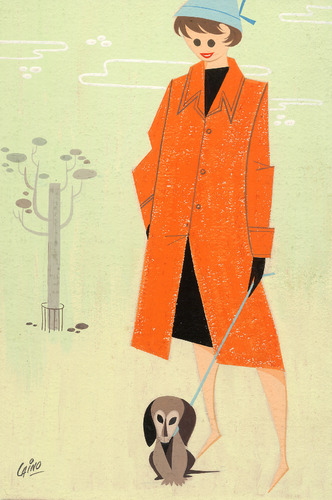 What would you say was the most important thing you learned during your career?
What would you say was the most important thing you learned during your career?
The most important lesson I learned is how to communicate and understand people. The art field opened a new world to me. It gave me the opportunity to meet writers, politicians, artists, painters, etc. In each country I resided, I learned invaluable lessons from my counterparts. I believe this has enriched my life.
Does this influence your cartoons in any way?
Definitely! Those observations influenced me to search more towards the life history and philosophy of important people. I remember going to the city coffee shops, sitting by the windows and spending hours on end watching people walk by as I was making notes and drawings over the observations. It’s a habit that I still practice. People are life, and their behavior tells a million of interesting stories.
Some of your newer works are colored digitally. When did you start using computers for your work?
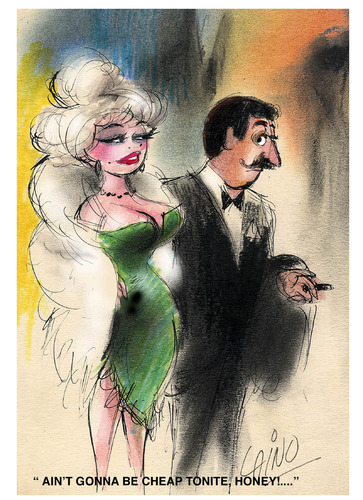 It’s been years. I remember my first computer was British-made and it was a small square box – about 20 cm. I had to use as a small black-and-white Sony TV as a monitor.
It’s been years. I remember my first computer was British-made and it was a small square box – about 20 cm. I had to use as a small black-and-white Sony TV as a monitor.
The funny thing about this whole situation was the fact that the computer, being British, used the metric system while my TV set was American. The connection would vary a few decimals and if, by chance, the computer would “move”, I would lose in matter of seconds what had taken me hours to accomplish.
Which part of your cartooning did you do on that British computer?
Well, it was kind of a “Mickey Mouse” computer. I don’t even remember the brand name. The printer was attached to it and printed only letters and numbers – no graphics whatsoever. Remember, this was in the early ‘70s before the world’s first commercial PCs with built-in floppies were sold in the marketplace. So, I never really used it for cartooning, much less commercial art.
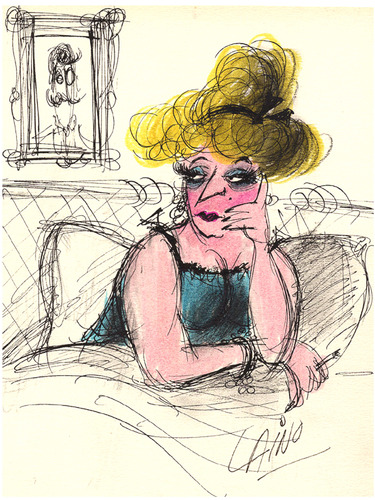 Did you still do cartoons when you had your advertising agency?
Did you still do cartoons when you had your advertising agency?
Unfortunately, my time for cartooning was getting shorter and shorter since I had to dedicate my full time to the agency. As Creative Art Director, my job was mostly doing layouts for the clients’ campaigns, although, I would sporadically do some cartoons.
You stayed in the US for quite a long time. Why did you decide to move back to Argentina?
In the course of the last six years, I’ve been asked that question many times. Things in Argentina are not like they used to be when I left in the 50’s. Having lived in USA for so many years it has been hard for me to acclimate myself. My wife Celeste, who’s American, and I have been trying to adjust to our new situation.
I must admit, though, that coming back had its rewards. I have received many accolades, among them stands out having been named “Illustrious Artist of the City of Rosario” in 2010.
So, people still remember you?
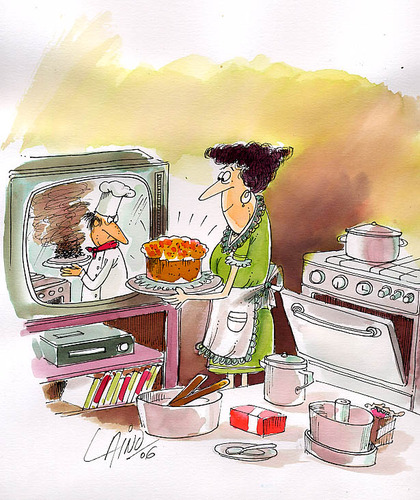 Older people, especially my colleagues, remember me as a well-known cartoonist and director of Dibujantes. The magazine was a learning tool in those years when there were no real art schools. This paved the way for many beginners who eventually became professionals. The young generation approaches me constantly searching for information and data. This is the main reason why I am re-editing the magazine via internet.
Older people, especially my colleagues, remember me as a well-known cartoonist and director of Dibujantes. The magazine was a learning tool in those years when there were no real art schools. This paved the way for many beginners who eventually became professionals. The young generation approaches me constantly searching for information and data. This is the main reason why I am re-editing the magazine via internet.
What was Dibujantes all about?
It was a kind of free-teaching-well-sought-after publication with articles on how to draw cartoons, stories of successful cartoonists and a lot of information about drawings written by well-known professionals. The magazine was limited in quantity, but still distributed all over the country.
The young generation wants to learn about the past and all those cartoonists they heard about. Since I was the director of such a publication they reach out to me – to hear the stories from the horse’s mouth. This is the main reason why I decided to re-edit the old publication page by page in the Internet in a PDF format. Thus everybody can enjoy the past history. Even though the original publication has been closed for so many years, it’s still sought after by collectors.
How closely did you follow the Argentinian cartoon business when you lived in the United States?
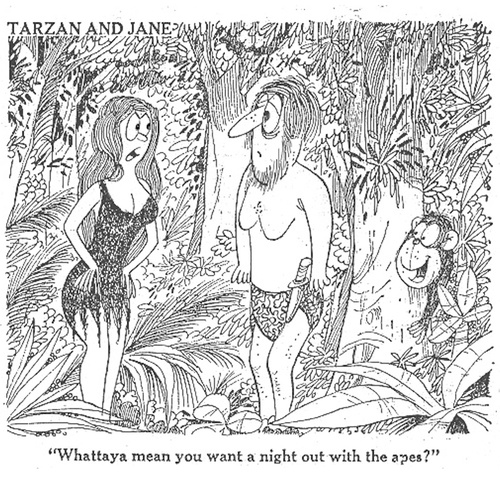 When I went abroad, at the beginning I kept in touch with some of my colleagues. Then, little by little, I lost contact.This was due to the fact that my new lifestyle was creating new environments and more obligations. Also, the political situation in Argentina made it difficult for my friends and colleagues to keep in close contact with me since they had many problems of their own.
When I went abroad, at the beginning I kept in touch with some of my colleagues. Then, little by little, I lost contact.This was due to the fact that my new lifestyle was creating new environments and more obligations. Also, the political situation in Argentina made it difficult for my friends and colleagues to keep in close contact with me since they had many problems of their own.
Time went by and after many years had passed, one day I was connected by chance through the Internet with César Da Col, a young artist involved with the Museo de la Caricatura in Buenos Aires. He knew me by name because of my background. We kept in touch writing each other back and forth. César suggested the idea of me telling stories of the past and my experiences while I was directing Dibujantes and about those pioneer cartoonists who were part of my past.
About this time, my wife Celeste and I came on vacation to Argentina to visit my family in Rosario, whom we hadn’t seen since the early ‘70s. At our arrival in Buenos Aires, I had an emotional experience at a museum gathering when I got reunited with a group of old friends and colleagues whom I hadn’t seen in more than fifty years.
That was when I started to write a series called “Historias del Pasado” – basically a recap of Argentinian humor from the past to the present.
Thanks for your time!
]]>